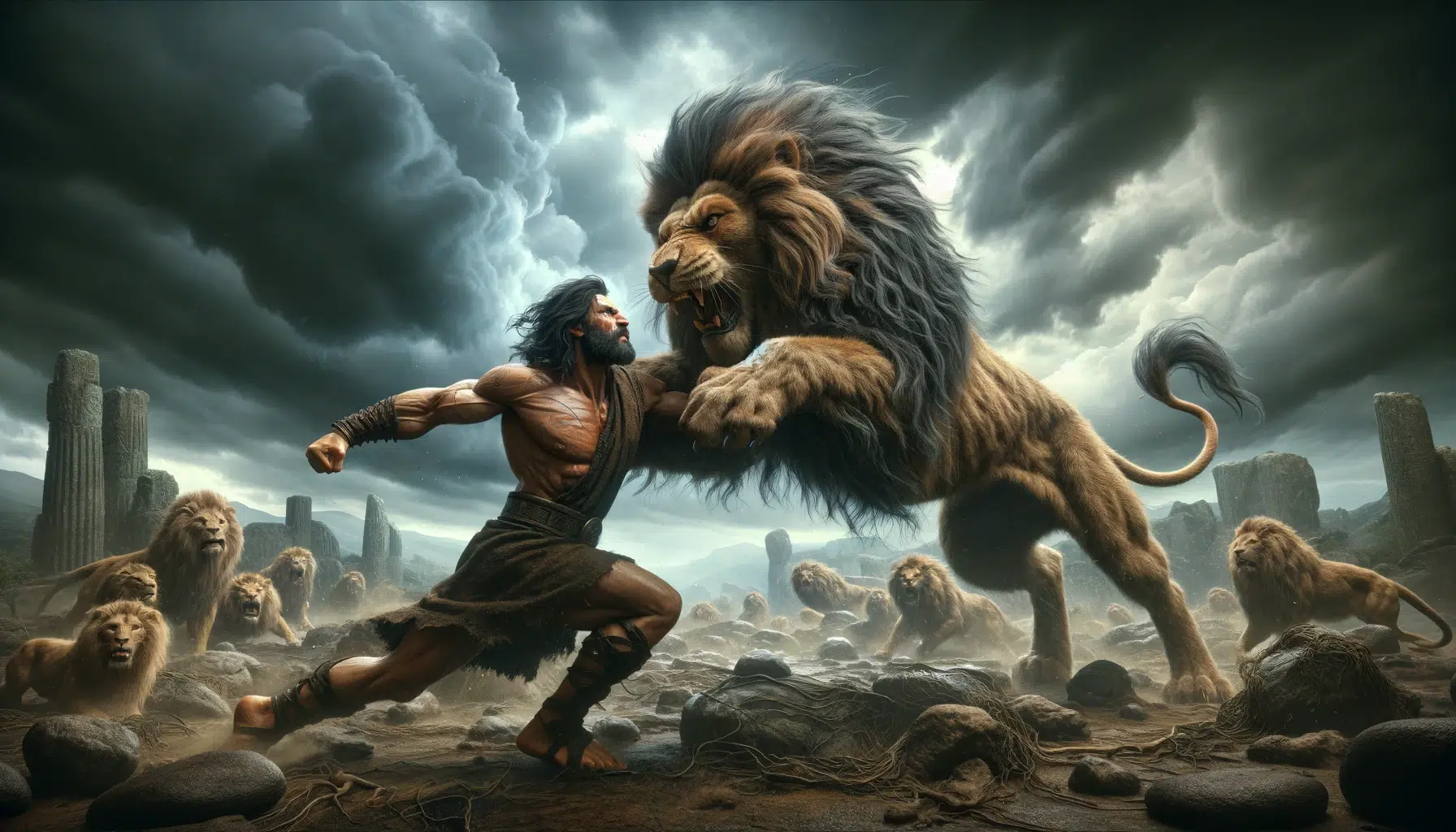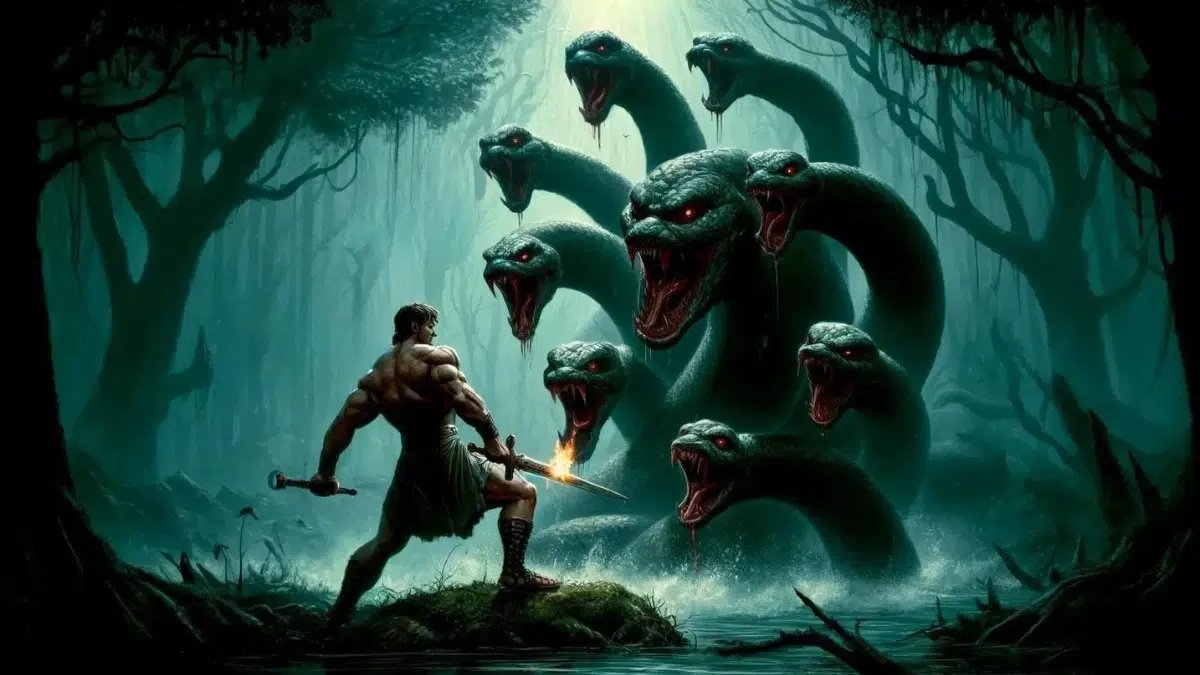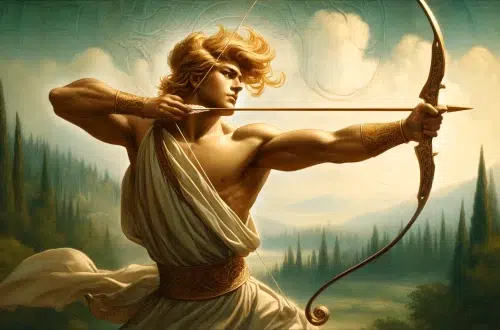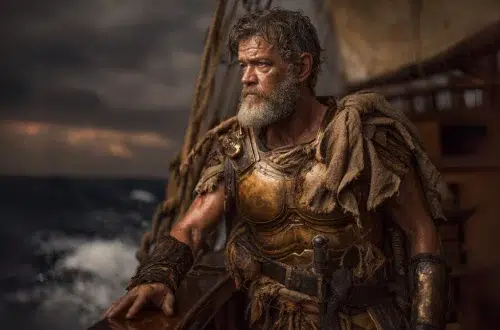
Hercules Labors: The Greek Hero’s Twelve Feats
Hercules labors became part of his legend.
Hercules was born a demi-god. His father was Zeus, king of the gods, and his mother was the mortal princess Alcmene, also the granddaughter of Perseus.
Zeus was married to Hera when he fathered Hercules, which would enrage Hera.
Being a demi-god, Hercules had superhuman strength even at birth. Hera hated Hercules as he was a reminder of her unfaithful husband, Zeus.
Initially Hera would try to kill the infant Hercules. She sent snakes into his crib to poison him.
However, Hercules with his super human strength and bravery, strangled the snakes. This just infuriated Hera.
Learn more about Zeus’s other children:
Hercules’s Mentors

As Hercules grew up he was taught many skills.
His mother’s husband, and step father Amphitryon, would teach how to drive a chariot.
He would learn the art of archery through instruction of King Eurytus.
According to Greek mythology King Eurytus of Thessaly was a skilled archer.
He shows Hercules the art of the bow and arrow, eventually being his most recognizable symbol and weapon.
He was also taught how to wrestle, box and fence. And learned about the arts, including literature and music.
As a young man he would show off his skills by killing the lion of Mount Cithaeron, after fifty days, which had been preying on the flocks nearby.
Hera Casts a Spell on Hercules

Hercules grew up and married Megara and they had children. Knowing how much Hercules loved his family, Hera she cast a spell on him.
This drove him temporarily insane. Under that spell Hercules would murder his wife and children.
Heartbroken Hercules sought help from his half-sibling Apollo, god of healing, so that he could make amends.
Impossible Tasks to Purify His Sins
The Delphic oracle then would instruct Hercules to purify his sins by serving King Eurystheus.
For the next twelve years of his life he was to carry out all of the tasks asked of him.
These 12 nearly impossible tasks (labors) would challenge Hercules’ incredible strength, bravery, and wit.
If Hercules were to complete these tasks, he would achieve immortality and be cleared of the guilt of killing his family.
In the myth, Hera, the queen of the Olympian gods, would actually assign the Twelve Labors to Hercules. Hera was hoping these tasks would be too hard for Hercules, leading to his destruction.
Yet, with his unmatched strength, skill, and wit, Hercules would manage to complete all the challenges with his strength and courage.
However, he did get help from other Olympian gods who came to his aid, like Hermes and Athena.
With the gods’ support and his own unmatched abilities, Hercules earned his legendary status.
The Twelve Labors of Hercules

The Twelve Labors of Hercules were tough tasks set by King Eurystheus.
| Labor | Challenge |
|---|---|
| 1 | Slaying the Nemean Lion |
| 2 | Defeating the nine-headed Hydra |
| 3 | Capturing the Golden Hind |
| 4 | Conquering the Erymanthian Boar |
| 5 | Cleaning the Augean stables in a single day |
| 6 | Slaying the Stymphalian Birds |
| 7 | Capturing the Cretan Bull |
| 8 | Stealing the Mares of Diomedes |
| 9 | Obtaining the girdle of Hippolyta, Queen of the Amazons |
| 10 | Conquering the cattle of the monster Geryon |
| 11 | Fetching the Golden Apples of the Hesperides |
| 12 | Conquering Cerberus, the three-headed dog of the underworld |
Both Apollo and Artemis, being gods of hunting and wilderness, are spiritually significant in labors that involve dealing with wild animals or navigating natural settings.
Their domains often overlap with the challenges Hercules faces.
As Hercules’ father, Zeus occasionally offers subtle support but generally does not intervene directly in the labors.
His role is more about maintaining the balance of fate and ensuring that Hercules can prove his heroism.
Perhaps the most significant divine influence throughout Hercules’ labors is Hera.
Her animosity towards Hercules, the son of Zeus is the underlying reason for the labors in the first place.
She continually tries to make his tasks more difficult, such inciting the Amazons against him during his quest for Hippolyta’s belt, or sending a gadfly to scatter the cattle of Geryon.
These gods and their involvement reflect the deeply intertwined relationships between the divine and mortal realms in Greek mythology.
Often illustrating broader themes of struggle, redemption, and the human condition through the lens of divine intervention and heroism.
First of Hercules Labors: Kill the Nemean Lion

This lion is no ordinary beast; its skin is so tough that no weapon can cut through it.
Hercules quickly finds out that arrows and swords do nothing. He has to think of another way to defeat this fierce animal.
With no gods to help him, Hercules uses his own strength. He waits for the lion to attack, then grabs it and holds on tight. He wrestles the lion and uses his powerful arms to strangle it.
This brave act takes a lot of effort and shows Hercules’ incredible power. He then cleverly made armory from the lion’s skin, showing his intelligence and power.
Killing the Nemean Lion is just the start of Hercules’ famous adventures.
It proves he is a true hero, capable of great feats.
This victory sets him up for the even tougher challenges ahead in his journey to complete the twelve labors.
Second of Hercules Labors: Slay the nine-headed Lernaean Hydra

Third of Hercules Labors: Capture the Ceryneian Hind

Hercules takes on his third labor: capturing the Ceryneian Hind.
This is no ordinary deer; it has golden antlers and hooves of bronze, and it’s incredibly fast. The hind is also sacred to Artemis, the goddess of the hunt, which makes this task even trickier.
Hercules can’t hurt the animal without angering the goddess.
For a full year, Hercules chases the hind across the mountains and forests. He needs to be careful and patient.
Finally, Hercules manages to corner the hind and catches it gently. He carries the hind all the way back to show he has completed his task.
Throughout this labor, Hercules shows respect for the gods by not harming the hind. Artemis watches his actions closely but does not help or interfere.
This task tests Hercules’ endurance and his ability to think about the consequences of his actions. It teaches him that some challenges require persistence and respect for the divine.
Gods Supporting in the Third Labor:
- Hermes occasionally plays a role in guiding Hercules on how to capture the Hind without causing harm, as it is sacred to Artemis.
- The hind is sacred to Artemis, the goddess of the hunt. Initially, Hercules is hesitant to capture it because he does not want to incur Artemis’s wrath. After capturing the hind, Hercules explains to Artemis that he was required to do so as part of his labors, and she allows him to take it after he promises to return it unharmed.
Fourth of Hercules Labors: Capture the Erymanthian Boar

Hercules faces his fourth labor: capturing the Erymanthian Boar. This wild boar is huge and fierce, rampaging through the forests and terrifying nearby villagers.
Hercules must bring it back alive, which adds to the challenge. This wild boar causes fear in Erymanthus.
As Hercules approaches the cold, wintry area where the boar roams, he devises a plan. Instead of attacking directly, he drives the boar into thick snow where its movements slow down.
The deep snow traps the boar, making it easier for Hercules to capture it without harming it.
Hercules uses ropes to secure the boar and carefully leads it out of the snowy mountains. He shows his strength and smart thinking by using the environment to his advantage.
This task does not involve help from any gods, emphasizing Hercules’ ability to handle tough situations on his own.
This labor not only tests Hercules’ physical strength but also his problem-solving skills.
Capturing the boar alive demonstrates his respect for nature and the creatures in it. It’s another step in his journey, proving he can overcome obstacles through clever tactics and sheer determination.
This task prepares him for more difficult challenges ahead.
Gods Supporting in the Fourth Labor:
- Hermes is sometimes said to give Hercules advice on how to drive the boar out of its lair using the snow.
- Apollo, as a god associated with protection from evil (among other aspects), could be seen as a spiritual guide in tasks involving dangerous creatures like the boar.
Fifth of Hercules Labors: Cleanse the Augean Stables

Hercules faces his fifth labor: cleaning the Augean stables.
These stables are huge and haven’t been cleaned for years, filled with a vast amount of cattle waste.
The challenge? Hercules needs to clean them in just one day. Instead of shoveling the waste, Hercules comes up with a smart solution.
He decides to use the power of nature to help him. He diverts two nearby rivers, directing their waters through the stables. The rushing water washes away all the filth, cleaning the stables quickly and efficiently.
This clever use of the rivers shows Hercules’ ability to think outside the box.
He completes this task without any direct help from the gods, proving his resourcefulness and intelligence.
However, the idea to reroute the rivers might have been inspired by Athena, the goddess of wisdom, according to some stories.
This subtle guidance highlights the gods’ interest in Hercules’ labors, even when they do not assist directly.
By successfully cleaning the stables, Hercules not only solves a huge problem but also impresses those who doubted he could do it in one day.
This labor teaches him the value of using his environment and natural resources to tackle seemingly impossible challenges.
Gods Supporting in the Fifth Labor:
- In some versions of the myth, Athena inspires Hercules to reroute the rivers Alpheus and Peneus to clean the stables, showing him a clever way to complete the task efficiently.
Sixth of Hercules Labors: Defeat Stymphalian Birds

Hercules takes on his sixth labor: defeating the Stymphalian Birds.
These are no ordinary birds; they have sharp, metallic feathers they can shoot like arrows and their droppings are toxic, ruining crops and water.
The birds live in a marshy area, making it hard to reach them.
Hercules needs a smart way to scare the birds into the air so he can deal with them safely. Luckily, Athena, the goddess of wisdom, helps him out.
She gives Hercules a pair of bronze clappers made by Hephaestus, the god of craftsmanship. These clappers make a loud noise that scares the birds.
Using the clappers, Hercules drives the birds up from the marshes. As they fly up, he shoots them with his bow and arrows. This action stops the birds from causing more harm to the local people and their land.
Athena’s assistance with the clappers is crucial for Hercules’ success.
This labor shows how Hercules uses not only his strength but also tools provided by the gods to overcome challenges.
It’s a great example of combining physical power with clever solutions to solve a problem.
Hercules learns that sometimes, the right tool can make a tough job much easier.
Gods Supporting in the Sixth Labor:
- Athena gives Hercules a pair of bronze clappers forged by Hephaestus. These clappers help scare the birds into the air, allowing Hercules to shoot them.
- Hephaestus provides the equipment, like the clappers used in the labor to scare the Stymphalian Birds.
Seventh of Hercules Labors: Capture The Cretan Bull

Hercules faces his seventh labor: capturing the Cretan Bull.
This bull is famous for its immense size and strength, rampaging across the island of Crete.
To start, Hercules travels to Crete, where he meets the bull in an open field.
The bull charges, but Hercules is ready. He grabs the bull by the horns and wrestles it to the ground.
Hercules shows his incredible strength by overpowering the bull without harming it. This labor requires Hercules to use his brute force and wrestling skills.
He does not receive any help from the gods this time, highlighting his ability to handle some challenges completely on his own.
Capturing the Cretan Bull alive proves Hercules’ skill in tackling and subduing powerful creatures.
It’s another example of his heroic abilities and his commitment to completing tasks that benefit others. This task not only tests his physical strength but also his determination and bravery.
By successfully capturing the bull, Hercules helps to restore peace on the island of Crete, showing that he can solve problems that are dangerous to others.
This labor teaches him the importance of courage and responsibility in facing formidable challenges.
Gods Supporting in the Seventh Labor:
- Poseidon is connected to the story through the Cretan Bull, which is part of Hercules’ seventh labor. This bull was originally given by Poseidon to Minos, the king of Crete.
Eighth of Hercules Labors: Capture the Mares of Diomedes

Hercules sets out to complete his eighth labor: capturing the Mares of Diomedes.
These are no ordinary horses; they are wild and man-eating, trained by their owner Diomedes to crave human flesh.
Hercules arrives at the land of the Bistones, where Diomedes keeps these dangerous mares. To capture them, Hercules first needs a plan to approach them safely.
He decides to use surprise to his advantage.
He quickly overpowers the keepers guarding the mares and sets the horses free from their stables.
However, the mares are violent and uncontrollable. In a daring move, Hercules feeds Diomedes to his own horses. This shocking action calms the mares down, making them easier to handle.
With no gods assisting him directly in this labor, Hercules relies on his own cunning and physical prowess.
The task is gruesome but shows his willingness to use extreme measures to complete his goals.
By capturing the mares, Hercules not only tames the dangerous animals but also rids the region of a brutal tyrant, Diomedes.
This labor teaches him the harsh realities of dealing with creatures twisted by cruelty and the tough decisions heroes sometimes have to make.
Nineth of Hercules Labors: The Belt of Hippolyte

Hippolyte, Queen of the Amazons, has a magical girdle given to her by her father, Ares, God of War.
This belt is a symbol of her authority and strength, and King Eurystheus wants Hercules to bring it back.
Hercules takes on his ninth labor: stealing the belt of Hippolyta.
He travels to the land of the Amazons, preparing for a tough confrontation.
However, when he arrives, Hippolyta is friendly. Impressed by his reputation she agrees to give him the belt without a fight.
But things take a sudden turn. Hera, the queen of the gods, wants to make Hercules’ task harder.
She disguises herself as an Amazon and spreads a rumor that Hercules plans to kidnap their queen. This causes the Amazons to attack Hercules.
The initial peaceful exchange is disrupted by Hera’s deception, which leads to conflict.
Believing he is under attack and needing to escape with the belt, Hercules fights back against the Amazons. In the ensuing battle, Hippolyta is killed, and Hercules retrieves the belt.
This labor shows Hercules not just using his strength but also dealing with deception and conflict caused by the gods.
Hera’s involvement adds a twist to this task, testing Hercules’ ability to handle unexpected challenges.
This labor illustrates the tragic consequences of misunderstandings and the influence of the gods in complicating Hercules’ tasks.
Tenth of Hercules Labors: Take the Cattle of Geryon

Hercules faces his tenth labor: stealing the cattle of the giant Geryon.
Geryon is unique because he has three bodies joined together. He lives far in the west on an island with his herd of beautiful red cattle, guarded by a two-headed dog named Orthrus.
Hercules travels a long distance to reach the island. When he arrives, he has to deal with Orthrus.
Hercules strikes the dog with his club to protect himself and move forward.
Next, he faces Geryon, who comes to defend his cattle. After a fierce battle, Hercules uses his strength and skills to overcome the giant.
With Geryon defeated, Hercules herds the cattle and starts his journey back.
However, the trip is not smooth.
Hera, who often tries to make Hercules’ tasks harder, sends gadflies to scatter the cattle, causing further delays and challenges.
Hercules shows persistence and cleverness in rounding up the cattle again. He overcomes natural and supernatural obstacles, proving his heroic qualities once more.
This labor not only tests his combat skills but also his endurance and determination to complete the tasks given to him.
Gods Supporting in the Tenth Labor:
- Hermes assists Hercules in reaching the island of Erytheia where Geryon keeps his cattle. He provides guidance on navigating the challenges Hercules encounters along the way.
Eleventh of Hercules Labors: Get the Golden Apples

Hercules embarks on his eleventh labor: retrieving the golden apples from the Garden of the Hesperides.
These apples are not ordinary fruit; they are magical and highly coveted.
The garden is at the edge of the world, guarded by a hundred-headed dragon named Ladon, and the trees are tended by the Hesperides, nymphs who are daughters of Atlas.
Hercules faces a long journey and several challenges to find the location of the garden.
Realizing he needs help, he seeks out Atlas, the Titan who holds up the sky. Atlas knows where the apples are because his daughters guard them.
Hercules makes a deal with Atlas. He agrees to hold up the sky temporarily if Atlas retrieves the apples for him.
Atlas agrees and fetches the apples, relieved to be free from holding the sky, even for a short while.
When Atlas returns, he suggests that he might leave Hercules holding the sky permanently.
But Hercules cleverly convinces Atlas to take the sky back so he can adjust his cloak. Once Atlas lifts the sky again, Hercules takes the golden apples and leaves.
This labor showcases Hercules’ strength and cunning. He manages to outsmart Atlas and complete his task without direct conflict.
Gods Supporting in the Eleventh Labor:
- Athena assists Hercules after he retrieves the golden apples. She either advises him on how to deal with Atlas or takes the apples herself to return them to their rightful place, ensuring that the task is completed without violating divine laws.
- Athena’s involvement highlights her role in guiding and supporting Hercules through his tasks, emphasizing her wisdom and protective nature toward heroes.
Twelfth of Hercules Labors: Capture Cerberus

Hercules faces his twelfth and final labor: capturing Cerberus, the three-headed dog guarding the entrance to the underworld.
This task is incredibly dangerous because Cerberus is a fierce and monstrous creature.
To start, Hercules travels to the underworld, a place no living person usually goes.
He must be careful and respectful because this is the realm of Hades, the god of the dead.
Hercules approaches Hades and asks for permission to take Cerberus to the surface.
Hades agrees but sets a condition: Hercules must capture Cerberus without using any weapons.
This means Hercules has to rely on his strength alone.
With courage and determination, Hercules wrestles Cerberus, managing to subdue the beast with his bare hands.
He uses his power to show dominance without harming Cerberus, respecting Hades’ condition.
After proving his ability to control Cerberus, Hercules brings the dog to the surface to complete his task.
He shows everyone that he has succeeded in capturing the fearsome guardian of the underworld.
With the help of Hades, who allows the trial under strict conditions, Hercules completes his final labor.
This shows his bravery and respect for the rules of gods and men. Hercules learns that even the most daunting challenges can be overcome with respect and strength.
Gods Supporting in the Twelfth Labor:
- Hades permits Hercules to enter the Underworld and set the terms for Hercules to capture Cerberus, stipulating that he must overpower the beast without using weapons.
- Hermes, the messenger god, along with Athena, guide Hercules to the underworld and helps him navigate this dark and perilous realm. Their guidance ensures Hercules’ safe passage but also aids in negotiating the terms of capturing Cerberus with Hades.
Conclusion
The Twelve Labors of Hercules mark the peak of his legendary actions. These were tasks King Eurystheus imposed on him for a crime.
Even though Hercules faced impossible challenges, he showed great strength, bravery, and wit.
He fought beasts like the Nemean Lion and the Lernaean Hydra. He even traveled to the Underworld to face Cerberus, the guard dog.
With help from gods like Athena and Hermes, he overcame Hera’s tests.
These Twelve Labors are now legendary, proving Hercules is one of the greatest heroes in Greek myths.
For centuries, Hercules’ heroic deeds in the Twelve Labors have amazed people. His tales show his incredible strength and willpower.
By finishing these incredibly tough tasks, Hercules became the top hero in Greece. This shows the lasting power of Greek mythology.
The Twelve Labors of Hercules remain a symbol of his great legacy. Through his unmatched skills, Hercules tackled every obstacle. He secured his place as a cherished figure in ancient stories.
These stories of his bravery keep inspiring us. They prove Hercules is a hero whose memory will live on forever.
Learn more about Greek mythology:




